《传热传质学》主要内容和专业词汇中英文对照
考研化工备考传热传质的重点知识点
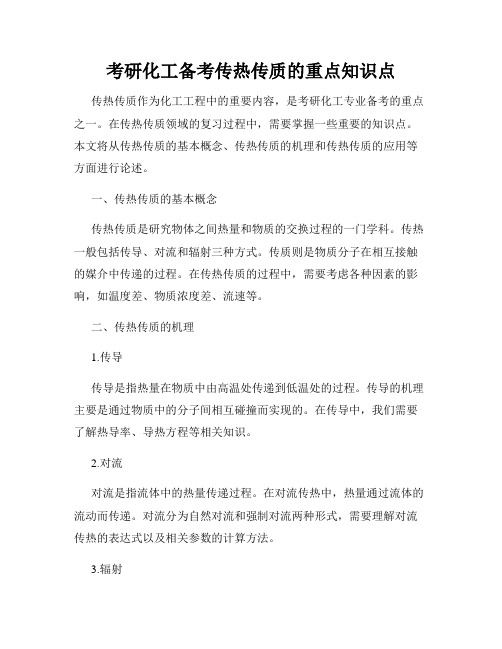
考研化工备考传热传质的重点知识点传热传质作为化工工程中的重要内容,是考研化工专业备考的重点之一。
在传热传质领域的复习过程中,需要掌握一些重要的知识点。
本文将从传热传质的基本概念、传热传质的机理和传热传质的应用等方面进行论述。
一、传热传质的基本概念传热传质是研究物体之间热量和物质的交换过程的一门学科。
传热一般包括传导、对流和辐射三种方式。
传质则是物质分子在相互接触的媒介中传递的过程。
在传热传质的过程中,需要考虑各种因素的影响,如温度差、物质浓度差、流速等。
二、传热传质的机理1.传导传导是指热量在物质中由高温处传递到低温处的过程。
传导的机理主要是通过物质中的分子间相互碰撞而实现的。
在传导中,我们需要了解热导率、导热方程等相关知识。
2.对流对流是指流体中的热量传递过程。
在对流传热中,热量通过流体的流动而传递。
对流分为自然对流和强制对流两种形式,需要理解对流传热的表达式以及相关参数的计算方法。
3.辐射辐射是指物体通过电磁波辐射传递热量的过程,无需介质的参与。
辐射传热是热量通过辐射在真空或透明介质中传递的。
辐射传热需要了解电磁波辐射的特性、辐射传热的计算方法等相关知识。
三、传热传质的应用传热传质在化工工程中有着广泛的应用。
下面列举一些常见的应用场景:1.换热器换热器是化工设备中常见的传热传质设备,主要用于实现不同物质之间的热量交换。
在备考过程中,需要掌握换热器的分类、换热器设计的基本原理以及换热器的性能计算方法。
2.蒸馏塔蒸馏塔是化工生产中用于分离液体混合物的设备,利用液体的汽化和冷凝过程实现组分的分离。
在蒸馏塔的设计和操作过程中,传热传质是必不可少的环节,需要理解传热传质对蒸馏过程的影响。
3.反应器反应器是化工过程中用于催化或热力学反应的设备。
在反应器的设计中,需要考虑传热传质对反应速率和选择性的影响。
因此,传热传质的知识对反应器的设计和优化具有重要意义。
4.干燥设备干燥是化工生产中常见的操作之一,用于去除物料中的水分。
传热传质学课程教学大纲

传热传质学课程教学大纲一、课程概述传热传质学是化工工程专业中的一门基础课程,主要研究物质之间的传热和传质现象及其规律。
本课程旨在培养学生对传热传质基本理论和应用技术的掌握,以及培养学生的创新思维和问题解决能力。
二、课程目标1. 理解传热传质学的基本概念和基本理论;2. 掌握传热传质 mathematical models 的建立与求解方法;3. 熟悉传热传质过程中的常用设备和实验方法;4. 能够通过工程实例分析、设计和改进传热传质系统;5. 培养学生的团队协作、创新思维和问题解决能力。
三、教学内容1. 传热传质的基本概念和物理机制:a) 热传导、对流传热、辐射传热;b) 扩散、对流传质;c) 传热传质的数学模型。
2. 传热传质的数学分析方法:a) 恒温边界条件下的传热传质计算;b) 变温边界条件下的传热传质计算;c) 换热器和传质设备的设计方法。
3. 传热传质的实验与应用:a) 传热传质实验室器材和常用实验方法;b) 传热传质在化工工程中的应用;c) 工程实例分析和案例研究。
四、教学方法1. 授课:a) 理论授课,讲授传热传质的基本概念和物理机制;b) 数学分析方法的讲解和示范;c) 实例分析和案例讨论。
2. 实验:a) 组织学生进行传热传质实验,加深理论内容的理解与应用;b) 引导学生独立设计和完成传热传质实验;c) 实验报告的撰写和展示。
3. 论文阅读与讨论:a) 指导学生阅读相关学术论文,理解最新的研究进展;b) 组织学生进行论文讨论,培养批判性思维和学术交流能力。
5. 小组项目:a) 分组进行传热传质工程实例的分析和设计;b) 定期小组讨论和汇报。
六、考核方式1. 平时成绩:a) 出勤和参与度;b) 实验操作和实验报告。
2. 期中考试:a) 理论知识考察;b) 解答题或计算题。
3. 期末考试:a) 理论知识考察;b) 解答题或计算题。
4. 小组项目和报告:a) 小组项目的分析与设计报告;b) 小组讨论和汇报。
传热-第11章-传质
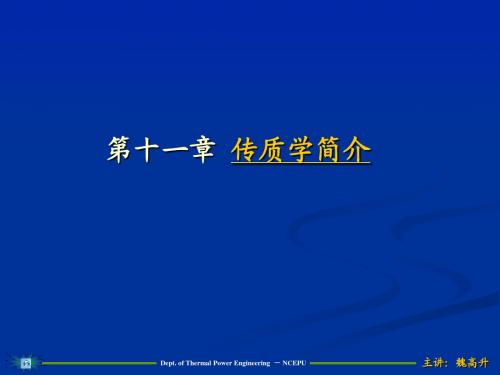
c N = D x
主讲:魏高升 主讲:
Dept. of Thermal Power Engineering - NCEPU
3. 两种典型的质扩散过程 等摩尔逆向扩散(双向扩散) (1)等摩尔逆向扩散(双向扩散) A 、 B 两种物质以相同的物质 的量通量密度相对扩散( 的量通量密度相对扩散(如气 体分的蒸馏过程, 体分的蒸馏过程,高、低沸点 组分潜热相近时,...) 组分潜热相近时,...) 假设系统总压为常数, 假设系统总压为常数,
DAB dpA , 积分可得 由式 N A = pA1 RT dx cA1 = RT DAB ( pA1 pA2 ) DAB = NA = ( cA1 cA2 ) RT x x
Dept. of Thermal Power Engineering - NCEPU
主讲:魏高升 主讲:
(2)单向扩散 假设: 假设: (1)扩散过程是稳态的; 扩散过程是稳态的; 系统是等温的; (2)系统是等温的; (3)水面上方气体空间的压 为常数; 力p0为常数; (4)混合气体可近似为理想 气体。 气体。 pA , pw的变化如图所示。 的变化如图所示。 根据上述假设, 根据上述假设,
Dept. of Thermal Power Engineering - NCEPU
N A = hm ( cA,w cA,f )
主讲:魏高升 主讲:
以空气平行吹过萘表面的对流传质过程为例, 以空气平行吹过萘表面的对流传质过程为例,
Dept. of Thermal Power Engineering - NCEPU
m n m
n
n
Nu Pr = Sh Sc
n
n
hl D ν D = λ hml a ν
《传热传质学》课程教学大纲 - 上海交通大学-机械与动力
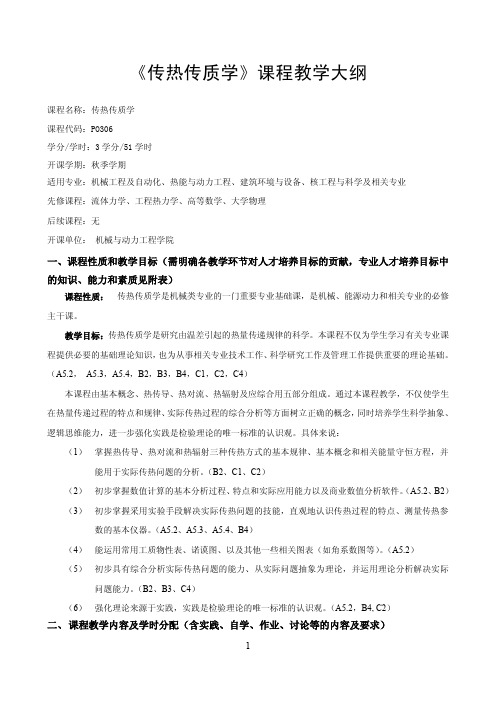
《传热传质学》课程教学大纲课程名称:传热传质学课程代码:PO306学分/学时:3学分/51学时开课学期:秋季学期适用专业:机械工程及自动化、热能与动力工程、建筑环境与设备、核工程与科学及相关专业先修课程:流体力学、工程热力学、高等数学、大学物理后续课程:无开课单位:机械与动力工程学院一、课程性质和教学目标(需明确各教学环节对人才培养目标的贡献,专业人才培养目标中的知识、能力和素质见附表)课程性质:传热传质学是机械类专业的一门重要专业基础课,是机械、能源动力和相关专业的必修主干课。
教学目标:传热传质学是研究由温差引起的热量传递规律的科学。
本课程不仅为学生学习有关专业课程提供必要的基础理论知识,也为从事相关专业技术工作、科学研究工作及管理工作提供重要的理论基础。
(A5.2,A5.3,A5.4,B2,B3,B4,C1,C2,C4)本课程由基本概念、热传导、热对流、热辐射及应综合用五部分组成。
通过本课程教学,不仅使学生在热量传递过程的特点和规律、实际传热过程的综合分析等方面树立正确的概念,同时培养学生科学抽象、逻辑思维能力,进一步强化实践是检验理论的唯一标准的认识观。
具体来说:(1)掌握热传导、热对流和热辐射三种传热方式的基本规律、基本概念和相关能量守恒方程,并能用于实际传热问题的分析。
(B2、C1、C2)(2)初步掌握数值计算的基本分析过程、特点和实际应用能力以及商业数值分析软件。
(A5.2、B2)(3)初步掌握采用实验手段解决实际传热问题的技能,直观地认识传热过程的特点、测量传热参数的基本仪器。
(A5.2、A5.3、A5.4、B4)(4)能运用常用工质物性表、诺谟图、以及其他一些相关图表(如角系数图等)。
(A5.2)(5)初步具有综合分析实际传热问题的能力、从实际问题抽象为理论,并运用理论分析解决实际问题能力。
(B2、B3、C4)(6)强化理论来源于实践,实践是检验理论的唯一标准的认识观。
(A5.2,B4, C2)二、课程教学内容及学时分配(含实践、自学、作业、讨论等的内容及要求)1、绪论(2学时):(B4, C2)本课程概论,并介绍热传导、热对流和热辐射的基本定义、基本计算公式、传热过程简单介绍以及热阻分析法。
传热传质学
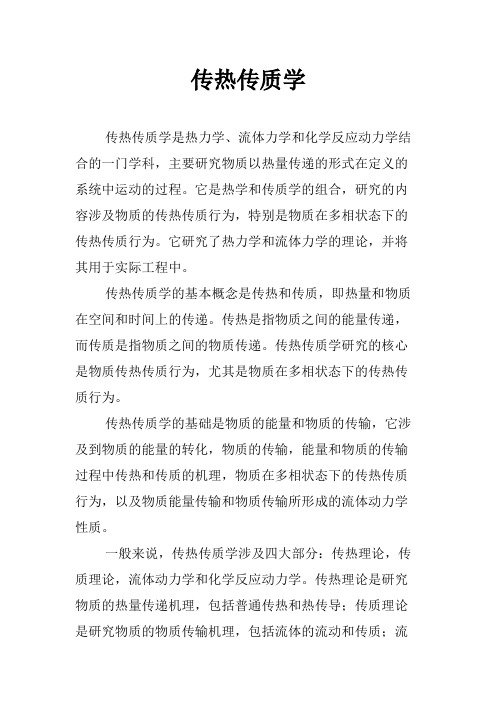
传热传质学传热传质学是热力学、流体力学和化学反应动力学结合的一门学科,主要研究物质以热量传递的形式在定义的系统中运动的过程。
它是热学和传质学的组合,研究的内容涉及物质的传热传质行为,特别是物质在多相状态下的传热传质行为。
它研究了热力学和流体力学的理论,并将其用于实际工程中。
传热传质学的基本概念是传热和传质,即热量和物质在空间和时间上的传递。
传热是指物质之间的能量传递,而传质是指物质之间的物质传递。
传热传质学研究的核心是物质传热传质行为,尤其是物质在多相状态下的传热传质行为。
传热传质学的基础是物质的能量和物质的传输,它涉及到物质的能量的转化,物质的传输,能量和物质的传输过程中传热和传质的机理,物质在多相状态下的传热传质行为,以及物质能量传输和物质传输所形成的流体动力学性质。
一般来说,传热传质学涉及四大部分:传热理论,传质理论,流体动力学和化学反应动力学。
传热理论是研究物质的热量传递机理,包括普通传热和热传导;传质理论是研究物质的物质传输机理,包括流体的流动和传质;流体动力学是研究物质的流体动力学性质,包括流体的流变、稳定凝结和动力学;化学反应动力学是研究物质的化学反应动力学性质,包括化学反应和传质现象。
传热传质学的应用很广泛,可以用于地热利用,核能热工学,燃烧工程,制冷空调工程,石油化工,原子能工程,矿物加工,食品加工等。
传热传质学是工程技术的重要分支,它在工程中的应用极其重要,研究传热传质学可以使工程技术的发展更加有效和高效。
总之,传热传质学是热力学、流体力学和化学反应动力学的结合,是探讨物质在空间和时间上的传热和传质的一门学科。
它的研究内容涉及热量传递和物质传递,其理论模型及应用技术有着重要的意义,可以帮助工程技术更加高效地发展。
传热学专业英语词汇

《传热学》课程专业英语词汇1. heat transfer 传热学2. heat conduction 导热3. convection heat transfer 对流换热4. thermal radiation 热辐射5. condensation heat transfer 凝结换热6. boiling heat transfer 沸腾换热7. number of heat transfer unit 传热单元数8. heat exchanger 换热器9. temperature field 温度场10. Fourier’s law 傅里叶定律11. Isothermal surface 等温面12. temperature gradient 温度梯度13. unsteady heat conduction 非稳态导热14. Isotherms 等温线15. lumped method 集总参数法16. thermal conductivity 导热系数17. heat flux 热流密度18. thermal resistance 热阻19. Newton’s law of cooling 牛顿冷却公式20. boundary layer 边界层21. thermal boundary layer 热边界层22. continuity equation 连续性方程23. laminar flow in tube 管内层流24. turbulent flow in tube 管内湍流25. in-tube boiling 管内沸腾26. dimensional analysis 量纲分析27. flow boundary layer 流动边界层28. fin 肋片29. fin efficiency 热效率30. Reynolds number 雷诺数31. Nusselt number 努谢尔数32. Prandtl number 普朗克数33. Planck’slaw 普朗克定律34. boundary layer integral equation 边界层积分方程35.boundary layer differential equation 边界层微分方程36.boundary condition 边界条件37.finite difference 差分38.initial condition 初始条件39.transmissivity 穿透比40.mass transfer process 传质过程41.natural convection in infinite space 大空间自然对流42.poor boiling 大容器沸腾43.partial differential equation of heat conduction 导热微分方程44.numerical solution of heat conduction 导热问题数值解45.directional radiation intensity 定向辐射强度46.log-mean temperature difference 对数平均温差47.multidimensional steady state heat conduction 多维稳态导热48.emissivity 发射率49.analytical solution of transient heat conduction 非稳态导热问题分析解50.Fourier number 傅里叶数work method of radiation heat exchange 辐射换热的网络法52.emissive power 辐射力53.Grashof number 格拉晓夫数54.insulating material 隔热材料(保温材料,绝热材料)55.spectral emissive power 光谱辐射力56.excess temperature 过余温度57.nucleate boiling 核态沸腾58.black body 黑体(绝对黑体)59.flow across single tube 横掠单管60.flow across non-circular cylinder 横掠非圆形截面柱体61.flow across tube bundles 横掠管束62.gray body 灰体63.effectiveness of heat exchanger 换热器的效能64.mixed convection 混合对流65.Kirchhoff’s law 基尔霍夫定律66.cross strings method 交叉线法67.view factor ,angle factor 角系数68.heat conduction with internal heat source 具有内热源的导热erning equation 控制方程place equation 拉普拉斯方程mbert’s law 兰贝特定律72.discretized equation 离散方程73.critical insulation radius 临界绝缘直径74 diffuse surface 漫射表面75.film-wise condensation 膜状凝结76.internal flow 内部流动77.counter-flow 逆流78.gaseous radiation 气体辐射79.enhancement of heat transfer 强化传热80.forced convection 强制对流81.heat pipe 热管82.heat transfer rate 热流量83.time constant 时间常数84.numerical solution 数值解85.Stefan-Boltzmann’s law 斯特潘-波耳兹曼定律86.velocity boundary layer 速度边界层87.solar radiation 太阳辐射88.characteristic length 特征长度89.characteristic number 特征数(准则数)90.irradiation 投入辐射91.turbulent flow 湍流92.external flow 外部流动93.flow along a flat plate 外掠平板94.Wien’s displacement law 维恩位移定律95.green house effect 温室效应96.steady –state heat conduction 稳态导热97.thermal resistance of fouling 污垢热阻98.absorptivity 吸收比99.back difference 向后差分100.forward difference 向前差分101.similarity principle 相似原理102.shape factor 形状因子103.1-dimensional steady state heat conduction 一维稳态导热。
传热传质学概念汇总
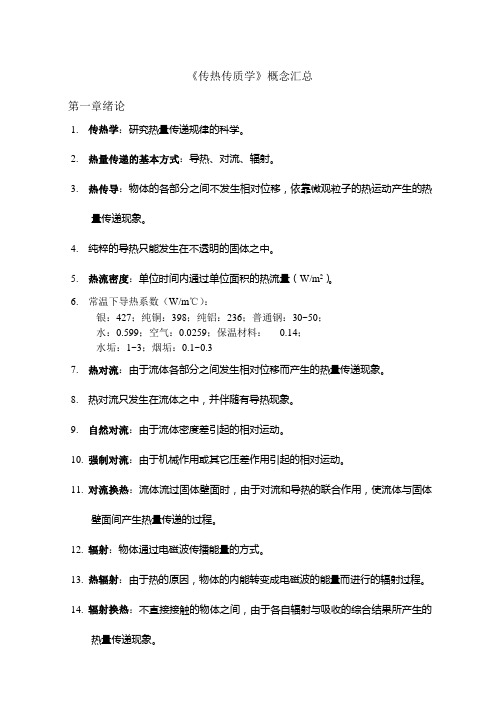
《传热传质学》概念汇总第一章绪论1.传热学:研究热量传递规律的科学。
2.热量传递的基本方式:导热、对流、辐射。
3.热传导:物体的各部分之间不发生相对位移,依靠微观粒子的热运动产生的热量传递现象。
4.纯粹的导热只能发生在不透明的固体之中。
5.热流密度:单位时间内通过单位面积的热流量(W/m2)。
6.常温下导热系数(W/m℃):银:427;纯铜:398;纯铝:236;普通钢:30~50;水:0.599;空气:0.0259;保温材料:0.14;水垢:1~3;烟垢:0.1~0.37.热对流:由于流体各部分之间发生相对位移而产生的热量传递现象。
8.热对流只发生在流体之中,并伴随有导热现象。
9.自然对流:由于流体密度差引起的相对运动。
10.强制对流:由于机械作用或其它压差作用引起的相对运动。
11.对流换热:流体流过固体壁面时,由于对流和导热的联合作用,使流体与固体壁面间产生热量传递的过程。
12.辐射:物体通过电磁波传播能量的方式。
13.热辐射:由于热的原因,物体的内能转变成电磁波的能量而进行的辐射过程。
14.辐射换热:不直接接触的物体之间,由于各自辐射与吸收的综合结果所产生的热量传递现象。
15. 传热过程:热流体通过固体壁面将热量传给另一侧冷流体的过程。
16. 传热系数:表征传热过程强烈程度的标尺,数值上等于冷热流体温差1℃时,单位面积上的热流量(W/m 2℃)。
17. 单位面积上的传热热阻:kR K 1= 18. 单位面积上的导热热阻:λδλ=R 19. 单位面积上的对流换热热阻:hR 1=α 20. 对比串联热阻大小可以找到强化传热的主要环节。
21. 单位:物理量的度量标尺。
22. 基本单位:基本物理量的单位。
23. 导出单位:由物理含义导出,以基本单位组成的单位。
24. 单位制:基本单位与导出单位的总和。
25. 常用单位换算:Wh kcal kJ kcal Nkgf Pa atm 163.1/1;1868.4180665.91;1013251====第二章 导热基本定律及稳态导热26. 温度场:物体中温度分布的总称。
传热传质学知识点总结
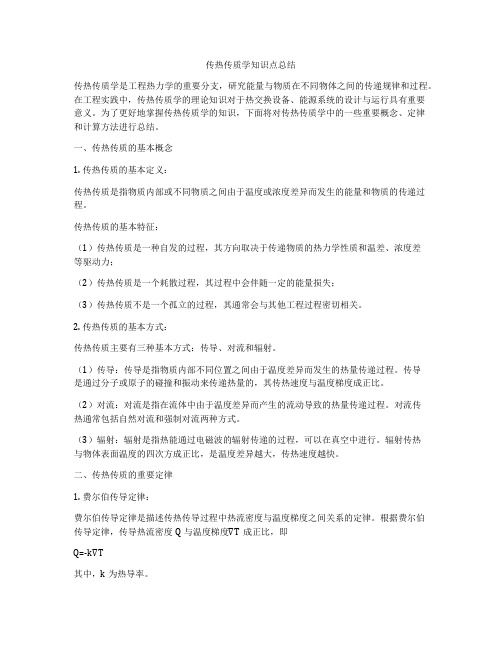
传热传质学知识点总结传热传质学是工程热力学的重要分支,研究能量与物质在不同物体之间的传递规律和过程。
在工程实践中,传热传质学的理论知识对于热交换设备、能源系统的设计与运行具有重要意义。
为了更好地掌握传热传质学的知识,下面将对传热传质学中的一些重要概念、定律和计算方法进行总结。
一、传热传质的基本概念1. 传热传质的基本定义:传热传质是指物质内部或不同物质之间由于温度或浓度差异而发生的能量和物质的传递过程。
传热传质的基本特征:(1)传热传质是一种自发的过程,其方向取决于传递物质的热力学性质和温差、浓度差等驱动力;(2)传热传质是一个耗散过程,其过程中会伴随一定的能量损失;(3)传热传质不是一个孤立的过程,其通常会与其他工程过程密切相关。
2. 传热传质的基本方式:传热传质主要有三种基本方式:传导、对流和辐射。
(1)传导:传导是指物质内部不同位置之间由于温度差异而发生的热量传递过程。
传导是通过分子或原子的碰撞和振动来传递热量的,其传热速度与温度梯度成正比。
(2)对流:对流是指在流体中由于温度差异而产生的流动导致的热量传递过程。
对流传热通常包括自然对流和强制对流两种方式。
(3)辐射:辐射是指热能通过电磁波的辐射传递的过程,可以在真空中进行。
辐射传热与物体表面温度的四次方成正比,是温度差异越大,传热速度越快。
二、传热传质的重要定律1. 费尔伯传导定律:费尔伯传导定律是描述传热传导过程中热流密度与温度梯度之间关系的定律。
根据费尔伯传导定律,传导热流密度Q与温度梯度∇T成正比,即Q=-k∇T其中,k为热导率。
2. 牛顿冷却定律:牛顿冷却定律是描述对流传热过程中传热速率与流体速度、温度差、传热面积之间的关系。
根据牛顿冷却定律,Q=hA(Ts-T∞)其中,h为对流换热系数,A为传热面积,Ts为传热面温度,T∞为流体温度。
3. 斯特藩-玻尔兹曼定律:斯特藩-玻尔兹曼定律是描述黑体辐射强度与温度之间的关系。
根据该定律,黑体辐射强度与温度的四次方成正比。
传热专业英语对照表
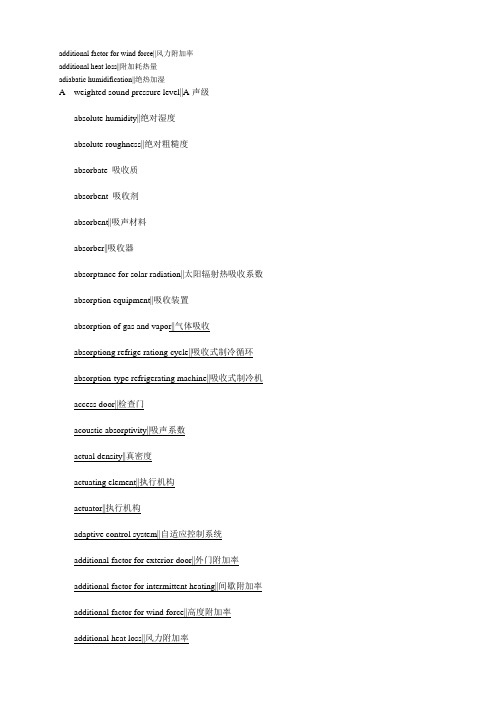
additional factor for wind force||风力附加率additional heat loss||附加耗热量adiabatic humidification||绝热加湿A-weighted sound pressure level||A声级absolute humidity||绝对湿度absolute roughness||绝对粗糙度absorbate 吸收质absorbent 吸收剂absorbent||吸声材料absorber||吸收器absorptance for solar radiation||太阳辐射热吸收系数absorption equipment||吸收装置absorption of gas and vapor||气体吸收absorptiong refrige rationg cycle||吸收式制冷循环absorption-type refrigerating machine||吸收式制冷机access door||检查门acoustic absorptivity||吸声系数actual density||真密度actuating element||执行机构actuator||执行机构adaptive control system||自适应控制系统additional factor for exterior door||外门附加率additional factor for intermittent heating||间歇附加率additional factor for wind force||高度附加率additional heat loss||风力附加率adiabatic humidification||附加耗热量adiabatic humidiflcation||绝热加湿adsorbate||吸附质adsorbent||吸附剂adsorber||吸附装置adsorption equipment||吸附装置adsorption of gas and vapor||气体吸附aerodynamic noise||空气动力噪声aerosol||气溶胶air balance||风量平衡air changes||换气次数air channel||风道air cleanliness||空气洁净度air collector||集气罐air conditioning||空气调节air conditioning condition||空调工况air conditioning equipment||空气调节设备air conditioning machine room||空气调节机房air conditioning system||空气调节系统air conditioning system cooling load||空气调节系统冷负荷air contaminant||空气污染物air-cooled condenser||风冷式冷凝器air cooler||空气冷却器air curtain||空气幕air cushion shock absorber||空气弹簧隔振器air distribution||气流组织air distributor||空气分布器air-douche unit with water atomization||喷雾风扇air duct||风管、风道air filter||空气过滤器air handling equipment||空气调节设备air handling unit room||空气调节机房air header||集合管air humidity||空气湿度air inlet||风口air intake||进风口air manifold||集合管air opening||风口air pollutant||空气污染物air pollution||大气污染air preheater||空气预热器air return method||回风方式air return mode||回风方式air return through corridor||走廊回风air space||空气间层air supply method||送风方式air supply mode||送风方式||air supply (suction) opening with slide plate||插板式送(吸)风口||air supply volume per unit area||单位面积送风量||air temperature||空气温度air through tunnel||地道风||air-to-air total heat exchanger||全热换热器air-to-cloth ratio||气布比air velocity at work area||作业地带空气流速air velocity at work place||工作地点空气流速air vent||放气阀air-water systen||空气—水系统airborne particles||大气尘air hater||空气加热器airspace||空气间层alarm signal||报警信号ail-air system||全空气系统all-water system||全水系统allowed indoor fluctuation of temperature and relative humidity||室内温湿度允许波动范围ambient noise||环境噪声ammonia||氨amplification factor of centrolled plant||调节对象放大系数amplitude||振幅anergy||@||angle of repose||安息角ange of slide||滑动角angle scale||热湿比angle valve||角阀annual [value]||历年值annual coldest month||历年最冷月annual hottest month||历年最热月anticorrosive||缓蚀剂antifreeze agent||防冻剂antifreeze agent||防冻剂apparatus dew point||机器露点apparent density||堆积密度aqua-ammonia absorptiontype-refrigerating machine||氨—水吸收式制冷机aspiation psychrometer||通风温湿度计Assmann aspiration psychrometer||通风温湿度计atmospheric condenser||淋激式冷凝器atmospheric diffusion||大气扩散atmospheric dust||大气尘atmospheric pollution||大气污染atmospheric pressure||大气压力(atmospheric stability||大气稳定度atmospheric transparency||大气透明度atmospheric turblence||大气湍流automatic control||自动控制automatic roll filter||自动卷绕式过滤器automatic vent||自动放气阀available pressure||资用压力average daily sol-air temperature||日平均综合温度axial fan||轴流式通风机azeotropic mixture refrigerant||共沸溶液制冷剂Bback-flow preventer||防回流装置back pressure of steam trap||凝结水背压力back pressure return余压回水background noise||背景噪声back plate||挡风板bag filler||袋式除尘器baghouse||袋式除尘器barometric pressure||大气压力basic heat loss||基本耗热量hend muffler||消声弯头bimetallic thermometer||双金属温度计black globe temperature||黑球温度blow off pipe||排污管blowdown||排污管boiler||锅炉boiller house||锅炉房boiler plant||锅炉房boiler room||锅炉房booster||加压泵branch||支管branch duct||(通风) 支管branch pipe||支管building envelope||围护结构building flow zones||建筑气流区building heating entry||热力入口bulk density||堆积密度bushing||补心butterfly damper||蝶阀by-pass damper||空气加热器〕旁通阀by-pass pipe||旁通管Ccanopy hood ||伞形罩capillary tube||毛细管capture velocity||控制风速capture velocity||外部吸气罩capturing hood ||卡诺循环Carnot cycle||串级调节系统cascade control system||铸铁散热器cast iron radiator||催化燃烧catalytic oxidation ||催化燃烧ceilling fan||吊扇ceiling panelheating||顶棚辐射采暖center frequency||中心频率central air conditionint system ||集中式空气调节系统central heating||集中采暖central ventilation system||新风系统centralized control||集中控制centrifugal compressor||离心式压缩机entrifugal fan||离心式通风机||check damper||(通风〕止回阀||check valve||止回阀||chilled water||冷水chilled water system with primary-secondary pumps||一、二次泵冷水系统chimney||(排气〕烟囱circuit||环路circulating fan||风扇circulating pipe||循环管circulating pump||循环泵clean room||洁净室cleaning hole||清扫孔cleaning vacuum plant||真空吸尘装置cleanout opening||清扫孔clogging capacity||容尘量close nipple||长丝closed booth||大容积密闭罩closed full flow return||闭式满管回水。
传热传质学概念汇总
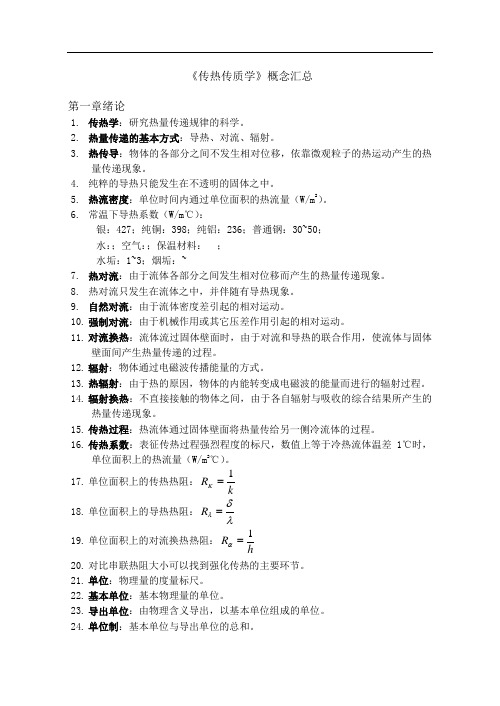
《传热传质学》概念汇总第一章绪论1. 传热学:研究热量传递规律的科学。
2. 热量传递的基本方式:导热、对流、辐射。
3. 热传导:物体的各部分之间不发生相对位移,依靠微观粒子的热运动产生的热量传递现象。
4. 纯粹的导热只能发生在不透明的固体之中。
5. 热流密度:单位时间内通过单位面积的热流量(W/m 2)。
6. 常温下导热系数(W/m ℃):银:427;纯铜:398;纯铝:236;普通钢:30~50;水:;空气:;保温材料:;水垢:1~3;烟垢:~7. 热对流:由于流体各部分之间发生相对位移而产生的热量传递现象。
8. 热对流只发生在流体之中,并伴随有导热现象。
9. 自然对流:由于流体密度差引起的相对运动。
10. 强制对流:由于机械作用或其它压差作用引起的相对运动。
11. 对流换热:流体流过固体壁面时,由于对流和导热的联合作用,使流体与固体壁面间产生热量传递的过程。
12. 辐射:物体通过电磁波传播能量的方式。
13. 热辐射:由于热的原因,物体的内能转变成电磁波的能量而进行的辐射过程。
14. 辐射换热:不直接接触的物体之间,由于各自辐射与吸收的综合结果所产生的热量传递现象。
15. 传热过程:热流体通过固体壁面将热量传给另一侧冷流体的过程。
16. 传热系数:表征传热过程强烈程度的标尺,数值上等于冷热流体温差1℃时,单位面积上的热流量(W/m 2℃)。
17. 单位面积上的传热热阻:k R K 1=18. 单位面积上的导热热阻:λδλ=R 19. 单位面积上的对流换热热阻:h R 1=α 20. 对比串联热阻大小可以找到强化传热的主要环节。
21. 单位:物理量的度量标尺。
22. 基本单位:基本物理量的单位。
23. 导出单位:由物理含义导出,以基本单位组成的单位。
24. 单位制:基本单位与导出单位的总和。
25. 常用单位换算: Wh kcal kJ kcal N kgf Pa atm 163.1/1;1868.4180665.91;1013251==== 第二章 导热基本定律及稳态导热26. 温度场:物体中温度分布的总称。
《传热传质学》课程教学大纲

《传热传质学》课程教学大纲(Heat and Mass Transfer Curriculum Outline)课程编号:10122007总学时:32学时总学分:2学分其中实验学分:0课程性质:学科基础课适用专业:机械设计制造及其自动化、材料成型与控制工程、农业机械及其自动化先修课程:高等数学、线性代数、大学物理后续课程:其它专业课程、课程设计、毕业设计主讲教师:程宏辉博士、讲师,研究方向为材料加工工程,hhchengnimte@金朝阳博士、讲师,研究方向为材料加工工程,zyjin@张敬尧硕士、讲师,研究方向为材料加工工程,jyzhang@一、教学目的与要求《传热传质学》是机械设计制造及其自动化、材料成型与控制工程、农业机械及自动化专业的学习基础课程。
通过传热传质学的学习,学生应对工业生产实际和日常生活中常见的传热现象有较深刻的理解,应能计算绝大多数稳态传导、对流和辐射及其组合情况下的换热问题,并对生产中常见的非稳态传热过程有一定分析计算能力。
对传质学的相关内容有一定初步了解。
设置本课程的具体要求是:使学习者掌握传热传质学的基本知识和理论,包括稳态导热、非稳态导热、对流换热、热辐射、对流传质、质扩散等基本概念和主要内容,能够分析工业和生活中一些复合传热过程,并能够计算热流量,总换热量、温度场等。
初步掌握传热传质学数值计算方法和实际应用。
了解传热传质学的发展过程和研究方法。
二、课程内容与学时安排第一章绪论[目的要求] 了解传热学的基本概念、研究对象及其在生产实践中的应用。
[教学内容] 导热、对流、热辐射的基本概念,气体、液体、固体的导热是如何实现的,对流换热的分类,物体的热辐射是如何实现的,液体的对流换热是如何实现的,傅里叶定律、牛顿冷却公式、Stefan-Boltzmann定律。
[重点难点] 传热传质学研究的连续性假设前提,三种基本的热量传递方式,导热、对流、热辐射的热量传递机理,传热计算过程的单位换算。
传热学专业英语词汇解读

Chapter 1 Thermodynamics and Heat Transfer 主要内容1.Concepts:heat (thermal energy)、heat transfer、thermodynamics、total amount of heat transfer、heat transfer rate、heat flux、conduction、convection、radiation2.Equations:1) The first law of thermodynamics (conservation of energy principle)2) Heat balance equation: a) closed system; b) open system (steady-flow)3) Fourier’s law of heat conduction4) Newton’s law of cooling5) Stefan-Boltzmann law主要专业词汇heat transfer 传热、热传递、传热学thermodynamics热力学caloric 热素specific heat 比热mass flow rate 质量流率latent heat 潜热sensible heat 显热heat flux热流密度heat transfer rate热流量total amount of heat transfer总热量conduction导热convection对流radiation辐射thermal conductivity 热导率thermal diffusivity 热扩散率convection/combined heat transfer coefficient 对流/综合换热系数emissivity 发射率absorptivity 吸收率simultaneous heat transfer 复合换热Chapter 2 Heat Conduction Equation主要内容1.Concepts:temperature field、temperature gradient、heat generation、initial condition、boundary condition、steady\transient heat transfer、uniform\nonuniform temperature distribution2.Equations:1) Fourier’s law of heat conduction (§2-1)2) Heat conduction equation (inrectangular\cylindrical\spherical coordinates) (§2-2、§2-3)3) Boundary conditions: (§2-4)a)Specified temperature B. C.b) Specified heat flux B. C. [special case(dt/dx=0):insulation、thermal symmetry];c) Convection B.C.d) Radiation B.C.e) Interface B.C.4) Average thermal conductivity k ave(§2-7)5) Solution of one-dimensional, steady heat conduction inplane walls、cylinders and spheres (k =const):a) no heat generation, specified B.C.: T(x) or T(r) (§2-5)Q(x) or Q(r), Q=constb) with heat generation, Specified B.C. or Convection B.C. : (§2-6)∆T max=T o-T s= gs2/2nk ; q(x)=gx/n; T s=T + gs/nh characteristic length S, shape factor n:plane walls —s = L (half thickness), n = 1cylinders ——s =r o, n = 2spheres ——s =r o, n =33.Methods: Solve a heat transfer problem1) Mathematical formulation (differential equation & B.C.)2) General solution of equation3) Application of B.C.s4) Unique solution of the problem主要专业词汇temperature field\distribution温度场\分布temperature gradient温度梯度heat generation热生成(热源)initial\boundary condition初始\边界条件transient heat transfer瞬态(非稳态)传热isothermal surface 等温面Heat conduction differential equation 导热微分方程trial and error method试算法iterate迭代convergence 收敛Chapter 3 Steady Heat Conduction主要内容1.Concepts:multilayer\composite wall overall heat transfer coefficient Uthermal resistance R t thermal contact resistance R c critical radius of insulation R crfin efficiency fin effectiveness2.Equations:✓Multiplayer plane wall、cylinders and spheres:✓Fin: fin equation——refer to the attachment.1) Uniform cross-section: refer to the attachment.2) Varying cross-section: refer to the attachment.主要专业词汇thermal resistance热阻parallel 并联in series串联thermal contact resistance 接触热阻composite wall 复合壁面thermal grease 热脂cross-section 横截面temperature execess 过余温度hyperbolic 双曲线的exponent 指数fin 肋(翅)片fin base 肋基fin tip 肋端fin efficiency 肋效率fin effectiveness 肋片有效度Chapter 4 Transient Heat Conduction主要内容1.Concepts:lumped system analysis characteristic length (L c=V/A)Biot number (Bi=hL c /k) Fourier number ( τ = at/L)2.Equations:●Bi≤0, lumped system analysis (§4-1)●Bi>0, Heisler/Grober charts OR analytical expressions1-D:a) infinite large plane walls, long cylinders and spheres (§4-2)b) semi-infinite solids (§4-3)multidimensional: product solution (§4-4)主要专业词汇lumped system analysis 集总参数法characteristic length 特征长度(尺寸)dimension 量纲nondimensionalize 无量纲化dimensionless quantity 无量纲量semi-infinite solid 半无限大固体complementary error function 误差余函数series 级数production solution 乘积解Chapter 5 Numerical Methods in Heat Conduction主要内容1.Concepts:control volume (energy balance) method、finite difference method、discretization、node、space step、time step、mesh Biot number、mesh Fourier number、mirror image concept、explicit/implicit method、stability criterion (primary coefficients ≥0)Numerical error: 1) discretization/truncation error; 2) round-off error2.Methods:Numerical solution:1) Discretization in space and time (∆x, ∆t);2) Build all nodes’finite difference formulations (including interior and boundary nodes);i.Finite difference methodii.Energy balance method (i.e.Control Volume method)3) Solution of nodal difference eqs. of heat conduction;i.Direct method: Gaussian Eliminationii.Iterative method: Gauss-Seidel iteration主要专业词汇control volume 控制容积finite difference有限差分Taylor series expression泰勒级数展开式mirror image concept 镜像法Elimination method 消元法direct/iterative method 直接/迭代方法explicit/implicit method 显式/隐式格式stability criterion 稳定性条件primary coefficients 主系数unconditionally 无条件地algebraic eq. 代数方程discretization/truncation error 离散/截断误差round-off error 舍入误差Chapter 6、7 Forced Convection and NaturalConvection主要内容1.Concepts:Nu、Re、Gr、PrForce/natural convection、external/internal flow、velocity/thermal boundary layerflow regimes、laminar/turbulent flowhydrodynamic/thermal entry region、fully developed regionCritical Reynolds Number (Re c)、hydraulic diameter (D h)、film temperature (T f)、bulk mean fluid temperature (T b)logarithmic mean temperature difference ( T ln)volume expansion coefficient (β= 1/T)effective thermal conductivity (K eff = K Nu)2.Equations:Drag force :F D = C f AρV2/2Heat transfer rate:Q = hA(T s-T )3.Typical Convection Phenomena:1) Forced convection:external flow——flow over flat plates (§6-4)——flow across cylinders and spheres (§6-5)internal flow——flow in tubes (§6-6)2) Natural convection:flow over surfaces (§7-2)flow inside enclosures (§7-3)主要专业词汇Force/natural convection 自然/强制对流laminar/turbulent flow 层/湍流boundary layer 边界层laminar sublayer 层流底层buffer layer 缓冲层transition region 过渡区flow regimes 流态inertia/viscous force 惯性/粘性力shear stress 剪切应力friction/drag coefficient 摩擦/阻力系数friction factor 摩擦因子dynamic/kinematic viscous 动力/运动粘度wake 尾流stagnation point 滞止点flow separation 流体分离vortex 漩涡rotational motion 环流velocity fluctuation 速度脉动hydrodynamic 水动力学的hydraulic diameter 水力直径fully developed region 充分发展段volume flow rate 体积流量arithmetic/logarithmic mean temperature difference 算术/对数平均温差volume expansion coefficient 体积膨胀系数interferometer 干涉仪asymptotic渐近线的effective thermal conductivity 有效热导率analogical method 类比法integral approach 积分近似法order of magnitude analysis 数量级分析法similarity principle 相似原理Chapter 9 Radiation Heat Transfer主要内容1.Concepts:black body、gray body、diffuse surface、emissive power (E)emissivity (ε)、absorptivity (α)、reflectivity (ρ)、transmissivity (τ) irradiation(G)、radiosity(J)、reradiating(adiabatic) surfaceview factor (F ij)、radiation network、space resistance、surface resistance radiation shieldgas radiation、transparent medium to radiation、absorbing and transmitting mediumws:Blackbody:(1) Plank’s law(2) Stefan-Boltzmann’s law(3) Wien’s displacement lawGraybody:(4) Kirchhoff’s lawActual body:E (T) = εE b(T) = εσT4W/m2Gas:(5) Beer’s law3.Calculation:1) View factor:reciprocity/summation/superposition/symmetry Rulecrossed-strings method2) Radiation heat transfer:Radiation networkOpen system:between two surface (e.g. two large parallel plates) Enclosure:2-surface enclosure;3-surface enclosureRadiation shield主要专业词汇thermal radiation热辐射、quantum theory量子理论、index of refraction 折射系数electromagnetic wave/spectrum 电磁波/波谱、ultraviolet (UV) rays紫外线、infrared (IR) rays 红外线absorptivity 吸收率、reflectivity 反射率、transmissivity 透射率、emissivity (ε) 发射率(黑度)、specular/diffuse reflection 镜反射/漫反射irradiation (incident radiation) 投入辐射、radiosity 有效辐射spectral/directional/total emissive power单色/定向/总辐射力fraction of radiation energy 辐射能量份额(辐射比)、blackbody radiation function 黑体辐射函数view factor 辐射角系数、crossed-strings method交叉线法、reciprocity/summation/superposition/symmetry Rule相互/完整/和分/对称性net radiation heat transfer 净辐射热流量radiation network 辐射网络图、space/surface radiation resistance 空间/表面辐射热阻、reradiating surface重辐射面、adiabatic 绝热的radiation shield遮热板transparent medium to radiation辐射透热体、absorbing and transmitting medium吸收-透过性介质Chapter 10 Heat Exchangers主要内容1.Concepts:heat exchanger type---- double-pipe、compact、shell-and-tube、plate-and-frame、regenerative heat exchangerparallel/counter/cross/multipass flowoverall heat transfer coefficient (U) fouling factor (R f)heat capacity rate capacity rationlog mean temperature difference (ΔT lm)heat transfer effectiveness (ε)number of transfer units (NTU)2.Equations:1) heat balance eq.: Q = C h (T h,in - T h,out)=C c(T c,out - T c,in)2) heat transfer eq.: Q = UAΔT lm( LMTD method)or Q = εQ max = εC min (T h,in ?C T c,in) ( ε-NTU method) 3.Methods:1) LMTD Method:select a heat exchangerKnown: C h、C c、3‘T’Predict: 1‘T’、Q、A2) ε-NTU Method:evaluate the performance of a specified heat exchangerKnown: C h、C c、UA、T h,in、T c,inPredict: Q、T h,out、T c,out主要专业词汇double-pipe/compact/shell-and-tube/plate-and-frame/regenerative heat exchanger套管式/紧凑式/壳管式/板式/蓄热(再生)式换热器parallel/counter/cross/multipass flow 顺流/逆流/叉流/多程流area density 面积密度tube/shell pass 管程/壳程static/dynamic type 静/动态型baffle 挡板header 封头nozzle管嘴guide bar 导向杆porthole 孔口gasket 垫圈lateral 侧面的/横向的fouling factor 污垢因子heat capacity rate 水当量heat transfer effectiveness (ε) 传热有效度number of transfer units (NTU) 传热单元数。
工程热术语翻译

《工程热力学》中英文对照词汇表Absolute entropy(绝对熵)Absolute pressure(绝对压力)Absolute temperature(绝对温度)Absolute zero of temperature(绝对零度)Absolute zero of temperature(绝对零度)Adiabatic enthalpy drop(绝热焓降)Adiabatic exponent(绝热指数)Adiabatic flame temperature(绝热燃烧温度)Adiabatic process(绝热过程)Adiabatic system(绝热系)Anergy(无效能,火无)Atmosphere(大气)Available energy(有效能)Avogadro’s hypothesis(阿伏伽德罗假说)Binary vapor cycle(两气循环)Boltzmann’s constant(玻尔兹曼常数)Carnot cycle(卡诺循环)Carnot cycle(卡诺循环)Carnot,N.L.S.(卡诺)Carnot’s theorem(卡诺定理)Celsius temperature scale(摄氏温标)Characteristic function(特性函数)Chemical equilibrium constant (化学平衡常数)Chemical equilibrium(化学平衡)Chemical potential(化学势)Chemical thermodynamics(化学热力学)Clapeyron equation(克拉贝龙方程)Classical thermodynamics(经典热力学)Clausius,R.(克劳修斯)Clausius-Clapeyron equation(克劳修斯-克拉贝龙方程)Closed system(闭口系)Closed system(闭口系统0 Coefficient of performance of refrigerator(制冷系数)Coefficient of thermal expansion (热膨胀系数)Coefficient of utilization of thermal energy(热能利用系数)Combined cycle(联合循环)Compressibility factor(压缩因子)Compression ratio of cycle(循环压缩比)Compression work(压缩功)Condition of phase equilibrium (相平衡条件)Condition of stability(稳定条件)Conservation of energy(能量守恒)Conservation of mass(质量守恒)Continuity equation(连续性方程)Control mass(控制质量)Control surface(控制面)Control volume(控制容积)Convergent nozzle(渐缩喷管)Convergent-divergent nozzle(缩放喷管)Criteria for equilibrium(平衡判据)Critical point(临界点)Critical pressure ratio(临界压力比)Cycle(循环)Degradation of energy(能量贬值)Density(密度)Dew-point(露点)Diesel cycle(狄赛尔循环)Diffuser(扩压管)Dissipation of energy(能量耗散)Divergent nozzle(渐扩喷管)Dolton’s law of partial pressure (道尔顿分压定律)Dual cycle(混合加热循环)Effect of dissipation(耗散效应)Energy(能量)Engineering thermodynamics(工程热力学)Enthalpy drop(焓降)Enthalpy(焓)Entropy balance equation(熵方程)Entropy(熵)Equation of energy for steady flow(稳定流动能量方程)Equation of state in reduced form(对比态方程)Equation of state(状态方程)Equilibrium state(平衡状态)Equilibrium(平衡)Exergy(火用)Expansion work(膨胀功)Extensive quantity(尺度量)Fahrenheit temperature scale(华氏温标)First law of thermodynamics(热力学第一定律)Flow work(流动功)Flux of entropy(熵流)Force(力)Free energy(自由能)Free enthalpy(自由焓)Free expansion(自由膨胀)Friction(摩擦)Gas constant(气体常数)Gas(气体)Gauge pressure(表压力)Generalized compressibility chart(通用压缩因子图)Generalized work(广义功)Generation of entropy(熵产)Gibbs’function(吉布斯函数)Gibbs’J.W.(吉布斯)Gibbs’phase rule(吉布斯相律)Gravitational potential(重力位能)Heat of combustion(燃烧热)Heat of reaction(反应热)《传热学》课程专业英语词汇 1. heat transfer 传热学2. heat conduction 导热 3. convection heat transfer 对流换热4. thermal radiation 热辐射 5. condensation heat transfer 凝结换热6. boiling heat transfer 沸腾换热7. number of heat transfer unit 传热单元数8. heat exchanger 换热器9. temperature field 温度场10. Fourier’s law 傅里叶定律11. Isothermal surface 等温面12. temperature gradient 温度梯度13. unsteady heat conduction 非稳态导热14. Isotherms 等温线15. lumped method 集总参数法16. thermal conductivity 导热系数17. heat flux 热流密度18. thermal resistance 热阻19. Newton’s law of cooling 牛顿冷却公式20. boundary layer 边界层21. thermal boundary layer 热边界层22. continuity equation 连续性方程23. laminar flow in tube 管内层流24. turbulent flow in tube 管内湍流25. in-tube boiling 管内沸腾26. dimensional analysis 量纲分析27. flow boundary layer 流动边界层28. fin 肋片29. fin efficiency 热效率30. Reynolds number 雷诺数31. Nusselt number 努谢尔数32. Prandtl number 普朗克数33. Planck’slaw普朗克定律34. boundary layer integral equation 边界层积分方程35.boundary layer differential equation 边界层微分方程36.boundary condition 边界条件37.finite difference 差分38.initial condition 初始条件39.transmissivity 穿透比40.mass transfer process 传质过程41.natural convection in infinite space 大空间自然对流42.poor boiling 大容器沸腾43.partial differential equation of heat conduction 导热微分方程44.numerical solution of heat conduction 导热问题数值解45.directional radiation intensity 定向辐射强度46.log-mean temperature difference 对数平均温差47.multidimensional steady state heat conduction 多维稳态导热48.emissivity 发射率49.analytical solution of transient heat conduction 非稳态导热问题分析解50.Fourier number 傅里叶数work method of radiation heat exchange 辐射换热的网络法52.emissive power 辐射力53.Grashof number 格拉晓夫数54.insulating material 隔热材料(保温材料,绝热材料)55.spectral emissive power 光谱辐射力56.excess temperature 过余温度57.nucleate boiling 核态沸腾58.black body 黑体(绝对黑体)59.flow across single tube 横掠单管60.flow across non-circular cylinder 横掠非圆形截面柱体61.flow across tube bundles 横掠管束62.gray body 灰体63.effectiveness of heat exchanger 换热器的效能64.mixed convection 混合对流65.Kirchhoff’s law 基尔霍夫定律66.cross strings method 交叉线法67.view factor ,angle factor 角系数68.heat conduction with internal heat source 具有内热源的导热erning equation 控制方程place equation 拉普拉斯方程mbert’s law 兰贝特定律72.discretized equation 离散方程73.critical insulation radius 临界绝缘直径74 diffuse surface 漫射表面75.film-wise condensation 膜状凝结76.internal flow 内部流动77.counter-flow 逆流78.gaseous radiation 气体辐射79.enhancement of heat transfer 强化传热80.forced convection 强制对流81.heat pipe 热管82.heat transfer rate 热流量83.time constant 时间常数84.numerical solution 数值解85.Stefan-Boltzmann’s law 斯特潘-波耳兹曼定律86.velocity boundary layer 速度边界层87.solar radiation 太阳辐射88.characteristic length 特征长度89.characteristic number 特征数(准则数)90.irradiation 投入辐射91.turbulent flow 湍流92.external flow 外部流动93.flow along a flat plate 外掠平板94.Wien’s displacement law 维恩位移定律95.green house effect 温室效应96.steady –state heat conduction 稳态导热97.thermal resistance of fouling 污垢热阻98.absorptivity 吸收比99.back difference 向后差分100.forward difference 向前差分101.similarity principle 相似原理102.shape factor 形状因子103.1-dimensional steady state heat conduction 一维稳态导热。
传热学英语词汇

传热学英语词汇一、基础词汇。
1. heat([hiːt],名词/动词)- 名词:热,热量。
例如:The heat from the sun is very strong.(来自太阳的热量很强。
)- 动词:加热。
例如:We need to heat the water.(我们需要加热水。
)2. transfer([trænsˈfɜː(r)],动词/名词)- 动词:传递,转移。
例如:Heat can transfer from one object to another.(热量能从一个物体传递到另一个物体。
)- 名词:转移,转让。
例如:The heat transfer in this system is complex.(这个系统中的热传递很复杂。
)3. conduction([kənˈdʌkʃn],名词)- 意思:传导。
例如:Conduction is one of the three modes of heat transfer.(传导是热传递的三种方式之一。
)4. convection([kənˈvekʃn],名词)- 意思:对流。
例如:Convection occurs in fluids.(对流发生在流体中。
)5. radiation([ˌreɪdiˈeɪʃn],名词)- 意思:辐射。
例如:The heat radiation from the fire can be felt from a distance.(从火发出的热辐射在远处就能感觉到。
)二、与物质相关词汇。
1. solid([ˈsɒlɪd],名词/形容词)- 名词:固体。
例如:Solids conduct heat differently from liquids.(固体传导热量的方式与液体不同。
)- 形容词:固体的,坚实的。
例如:A solid object has a definite shape.(固体物体有确定的形状。
专业英语3传热

emissivity n. [物]发射率 物 发射率 arbitrary adj. 任意的 武断的 独裁的 任意的, 武断的, 独裁的, 专断的 somewhat adv. 稍微 有点 有些 稍微, 有点, homogeneous adj. 同类的 相似的 均一 同类的, 相似的, 的, 均匀的 item n. (可分类或列举的 项目 条款 (消 可分类或列举的)项目 可分类或列举的 项目, 条款, 消 息、情报等的)一则 一条 情报等的 一则, 一则 so long as adv. 只要 geometric adj. 几何的 几何学的 几何的, configuration n. 构造 结构 配置 外形 构造, 结构, 配置,
critical pressure n. [物]临界压力 物 临界压力 British thermal unit(Btu) n.英热单位 一 英热单位(一 英热单位 种热量单位) 种热量单位 Fahrenheit adj. 华氏温度计的 n. 华氏温 度计, 度计 华氏温度计 vibration n. 振动 颤动 摇动 摆动 振动, 颤动, 摇动, just as adv. 正象 viz. <拉> 即, 就是 读做 就是(读做 读做namely) 拉 insulator n. 绝缘体 绝热器 绝缘体,
moderately adv. 适度地 kinetic adj. (运)动的 动力 学)的 动的, 运 动的 动力(学 的 kinetic energy 动能 open question 未决问题 容易讨论的问题 未决问题,容易讨论的问题 clarification n. 澄清 净化 澄清, collide vi. 碰撞 抵触 碰撞, momentum n. 动力 要素 动力, transport vt. 传送 运输 流放 放逐 传送, 运输, 流放, magnitude n. 大小 数量 巨大 广大 量级 大小, 数量, 巨大, 广大, tabular adj. 制成表的 扁平的 表格式的 平坦 制成表的, 扁平的, 表格式的, 列表, 的 vi. 列表 排成表格式
传热传质基本理论
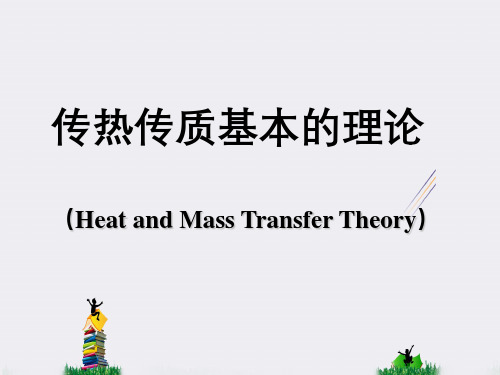
ujf xi
)
1 Vf
Ain(ip( xuij u xij)n )jdA
(cf
t
xjujfcf) xj(Df cxjf
Df V
A cinnijd
A u ~jc ~f)
1 c
VAinD i f xjnjdA
46
Subtracting the volume-averaged equations from the
u j 0 x j
u ti xjuju i1 x p i xj
( u i uj) xj xi
c t xj
ujcxj
(Df xcj)
45
Volume-averaged macroscopic GEs
u j f 0 x j
uif t
xj
ujf
uif
1f pxi f
(uif
44
Theoretical analyses
Volume average
1 dV V Vf
Intrinsic average
f 1 dV f
Vf Vf
f ~ 1 dA V Aint
Microscopic governing equations
Schematic of a porous media
(1) 浓度梯度引起的分子扩散 (2) 温度梯度引起的热扩散 (3) 压力梯度引起的压力扩散 (4) 除重力外的其它外力引起的强迫扩散 (5) 强迫对流传质 (6) 自然对流传质 (7) 紊流传质 (8) 相际传质
R.B. Bird, Theory of Diffusion, Adv. Chem. Eng., 1956 (1) 170.
u~kc~f
传热传质学文集
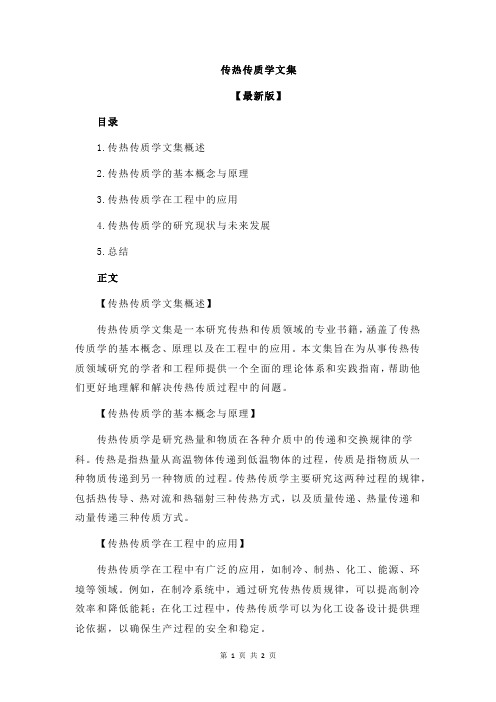
传热传质学文集【最新版】目录1.传热传质学文集概述2.传热传质学的基本概念与原理3.传热传质学在工程中的应用4.传热传质学的研究现状与未来发展5.总结正文【传热传质学文集概述】传热传质学文集是一本研究传热和传质领域的专业书籍,涵盖了传热传质学的基本概念、原理以及在工程中的应用。
本文集旨在为从事传热传质领域研究的学者和工程师提供一个全面的理论体系和实践指南,帮助他们更好地理解和解决传热传质过程中的问题。
【传热传质学的基本概念与原理】传热传质学是研究热量和物质在各种介质中的传递和交换规律的学科。
传热是指热量从高温物体传递到低温物体的过程,传质是指物质从一种物质传递到另一种物质的过程。
传热传质学主要研究这两种过程的规律,包括热传导、热对流和热辐射三种传热方式,以及质量传递、热量传递和动量传递三种传质方式。
【传热传质学在工程中的应用】传热传质学在工程中有广泛的应用,如制冷、制热、化工、能源、环境等领域。
例如,在制冷系统中,通过研究传热传质规律,可以提高制冷效率和降低能耗;在化工过程中,传热传质学可以为化工设备设计提供理论依据,以确保生产过程的安全和稳定。
【传热传质学的研究现状与未来发展】随着科学技术的进步,传热传质学得到了广泛关注和深入研究。
目前,研究者们在传热传质学的理论研究、数值模拟和实验技术等方面取得了显著成果。
然而,传热传质学仍面临诸多挑战,如复杂环境下的传热传质过程、多相流体中的传热传质、微尺度传热传质等。
因此,未来传热传质学的研究将继续深入,以满足不断发展的工程技术需求。
【总结】传热传质学文集是一本关于传热传质领域的专业书籍,内容包括传热传质学的基本概念、原理以及在工程中的应用。
传热传质学在工程中有广泛的应用,研究者们在该领域取得了显著成果,但仍面临诸多挑战。
- 1、下载文档前请自行甄别文档内容的完整性,平台不提供额外的编辑、内容补充、找答案等附加服务。
- 2、"仅部分预览"的文档,不可在线预览部分如存在完整性等问题,可反馈申请退款(可完整预览的文档不适用该条件!)。
- 3、如文档侵犯您的权益,请联系客服反馈,我们会尽快为您处理(人工客服工作时间:9:00-18:30)。
《传热传质学》主要内容和专业词汇中英文对照Chapter 1 Thermodynamics and Heat Transfer主要内容1.Concepts:heat (thermal energy)、heat transfer、thermodynamics、total amount of heat transfer、heat transfer rate、heat flux、conduction、convection、radiation2.Equations:1) The first law of thermodynamics (conservation of energy principle)2) Heat balance equation: a) closed system; b) open system (steady-flow)3) Fourier’s law of heat conduction4) Newton’s law of cooling5) Stefan-Boltzmann law主要专业词汇heat transfer 传热、热传递、传热学thermodynamics热力学caloric 热素specific heat 比热mass flow rate 质量流率latent heat 潜热sensible heat 显热heat flux热流密度heat transfer rate热流量total amount of heat transfer总热量conduction导热convection对流radiation辐射thermal conductivity 热导率thermal diffusivity 热扩散率convection/combined heat transfer coefficient 对流/综合换热系数emissivity 发射率absorptivity 吸收率simultaneous heat transfer 复合换热Chapter 2 Heat Conduction Equation主要内容3.Concepts:temperature field、temperature gradient、heat generation、initial condition、boundary condition、steady\transient heat transfer、uniform\nonuniform temperature distribution4.Equations:1) Fourier’s law of heat conduction (§2-1)2) Heat conduction equation (in rectangular\cylindrical\spherical coordinates)(§2-2、§2-3)3) Boundary conditions: (§2-4)a)Specified temperature B. C.b) Specified heat flux B. C. (special case: insulation、thermal symmetry);c) Convection B.C.d) Radiation B.C.e) Interface B.C.4) Average thermal conductivity k ave(§2-7)5) Solution of one-dimensional, steady heat conduction in plane walls、cylinders andspheres (k =const):a) no heat generation, specified temperature B.C.: (§2-5)T(x) or T(r);Q(x) or Q(r), Q=constb) with heat generation, Specified temperature B.C. or Convection B.C. : (§2-6)∆T max=T o-T s= gs2/2nk ; q(x)=gx/n; T s=T + gs/nhcharacteristic length S, shape factor n:plane walls — s = L (half thickness), n = 1cylinders ——s = r o, n = 2spheres ——s = r o, n =35.Methods: Solve a heat transfer problem1) Mathematical formulation (differential equation & B.C.)2) General solution of equation3) Application of B.C.s4) Unique solution of the problemtemperature field\distribution 温度场\分布 temperature gradient 温度梯度 heat generation 热生成(热源) initial\boundary condition 初始\边界条件 transient heat transfer 瞬态(非稳态)传热 isothermal surface 等温面 Heat conduction differential equation 导热微分方程trial and error method 试算法 iterate 迭代 convergence 收敛Chapter 3 Steady Heat Conduction主要内容6. Concepts:multilayer\composite wall overall heat transfer coefficient Uthermal resistance R t thermal contact resistance R ccritical radius of insulation R crfin efficiency fin effectiveness7. Equations:✓ Multiplayer plane wall 、cylinders and spheres: 12totalT T Q UA T R ∞∞-==∆& ✓ Fin: fin equation ——0)()(=--∞T T hp dxdT kA dx d c1) Uniform cross-section:2) Varying cross-section: )(fin fin max fin,fin fin ∞-==T T hA Q Q b ηη&&thermal resistance热阻parallel 并联in series串联thermal contact resistance 接触热阻composite wall 复合壁面thermal grease 热脂cross-section 横截面temperature execess 过余温度hyperbolic 双曲线的exponent 指数fin 肋(翅)片fin base 肋基fin tip 肋端fin efficiency 肋效率fin effectiveness 肋片有效度Chapter 4 Transient Heat Conduction主要内容8.Concepts:lumped system analysis characteristic length (L c=V/A)Biot number (Bi=hL c /k) Fourier number ( τ = at/L)9.Equations:●Bi≤0, lumped system analys is (§4-1)●Bi>0, Heisler/Grober charts OR analytical expressions1-D:a) infinite large plane walls, long cylinders and spheres (§4-2)b) semi-infinite solids (§4-3)multidimensional: product solution (§4-4)主要专业词汇lumped system analysis 集总参数法characteristic length 特征长度(尺寸)dimension 量纲nondimensionalize 无量纲化dimensionless quantity 无量纲量semi-infinite solid 半无限大固体complementary error function 误差余函数series 级数production solution 乘积解Chapter 5 Numerical Methods in Heat Conduction主要内容10.Concepts:control volume (energy balance) method、finite difference method、discretization、node、space step、time step、mesh Biot number、mesh Fourier number、mirror image concept、explicit/implicit method、stability criterion (primary coefficients ≥0)Numerical error: 1) discretization/truncation error; 2) round-off error11.Methods:Numerical solution:1) Discretization in space and time (∆x, ∆t);2) Build all nodes’ finite difference formulations (including interior and bou ndary nodes);i.Finite difference methodii.Energy balance method (i.e. Control V olume method)3) Solution of nodal difference eqs. of heat conduction;a)Direct method: Gaussian Eliminationb)Iterative method: Gauss-Seidel iteration主要专业词汇control volume 控制容积finite difference有限差分Taylor series expression泰勒级数展开式mirror image concept 镜像法Elimination method 消元法direct/iterative method 直接/迭代方法explicit/implicit method 显式/隐式格式stability criterion 稳定性条件primary coefficients 主系数unconditionally 无条件地algebraic eq. 代数方程discretization/truncation error 离散/截断误差round-off error 舍入误差Chapter 6、7 Forced Convection and Natural Convection主要内容12.Concepts:Nu、Re、Gr、PrForce/natural convection、external/internal flow、velocity/thermal boundary layer flow regimes、laminar/turbulent flowhydrodynamic/thermal entry region、fully developed regionCritical Reynolds Number (Re c)、hydraulic diameter (D h)、film temperature (T f)、bulk mean fluid temperature (T b)logarithmic mean temperature difference ( ∆T ln)volume expansion coefficient (β = 1/T)effective thermal conductivity (K eff = K Nu)evaporation、boiling、condensation、nucleation sitepool/flow boiling、subcooled / satuated boilingnatural convection / uncleate / transition /film boilingburn out point13.Equations:Drag force :F D = C f AρV2/2Heat transfer rate:Q = hA(T s-T∞)3.Typical Convection Phenomena:1) Forced convection:external flow——flow over flat plates (§6-4)——flow across cylinders and spheres (§6-5)internal flow——flow in tubes (§6-6)2) Natural convection:flow over surfaces (§7-2)flow inside enclosures (§7-3)3) Boiling Heat Transfer主要专业词汇Force/natural convection 自然/强制对流laminar/turbulent flow 层/湍流boundary layer 边界层laminar sublayer 层流底层buffer layer 缓冲层transition region 过渡区flow regimes 流态inertia/viscous force 惯性/粘性力shear stress 剪切应力friction/drag coefficient 摩擦/阻力系数friction factor 摩擦因子dynamic/kinematic viscous 动力/运动粘度wake 尾流stagnation point 滞止点flow separation 流体分离vortex 漩涡rotational motion 环流velocity fluctuation 速度脉动hydrodynamic 水动力学的hydraulic diameter 水力直径fully developed region 充分发展段volume flow rate 体积流量arithmetic/logarithmic mean temperature difference 算术/对数平均温差volume expansion coefficient 体积膨胀系数interferometer 干涉仪asymptotic渐近线的effective thermal conductivity 有效热导率evaporation 蒸发boiling 沸腾condensation 凝结pool boiling池内(大容器)沸腾flow boiling(管内)强制对流沸腾subcooled / satuated boiling 过冷/饱和沸腾nucleation site 汽化核心uncleate / transition /film boiling 核态/过渡/膜态沸腾burnout point烧毁点surface tension 表面张力vapor bubble 汽泡excess temperature 过热度thermodynamic equilibrium 热力平衡phase change/transformation 相变latent heat of vaporization 汽化潜热analogical method 类比法integral approach 积分近似法order of magnitude analysis 数量级分析法similarity principle 相似原理Chapter 9 Radiation Heat Transfer主要内容14.Concepts:black body、gray body、diffuse surface、emissive power (E)emissivity (ε)、absorptivity (α)、reflectivity (ρ)、transmissivity (τ)irradiation(G)、radiosity(J)、reradiating(adiabatic) surfaceview factor (F ij)、radiation network、space resistance、surface resistance radiation shieldgas radiation、transparent medium to radiation、absorbing and transmitting medium ws:Blackbody:(1) Planck’s distrib ution law(2) Stefan-Boltzmann’s law(3) Wien’s displacement lawGraybody:(4) Kirchhoff’s lawActual body:E (T) = ε E b(T) = ε σT4W/m2Gas:(5) Beer’s law3.Calculation:1) View factor:reciprocity/summation/superposition/symmetry Rulecrossed-strings method2) Radiation heat transfer:Radiation networkOpen system:between two surface (e.g. two large parallel plates)Enclosure:2-surface enclosure;3-surface enclosureRadiation shield主要专业词汇thermal radiation热辐射、quantum theory量子理论、index of refraction 折射系数electromagnetic wave/spectrum 电磁波/波谱、ultraviolet (UV) rays紫外线、infrared (IR) rays 红外线absorptivity 吸收率、reflectivity 反射率、transmissivity 透射率、emissivity (ε) 发射率(黑度)、specular/diffuse reflection 镜反射/漫反射irradiation (incident radiation) 投入辐射、radiosity 有效辐射spectral/directional/total emissive power单色/定向/总辐射力fraction of radiation energy 辐射能量份额(辐射比)、blackbody radiation function 黑体辐射函数view factor 辐射角系数、crossed-strings method交叉线法、reciprocity/summation/superposition/symmetry Rule相互/完整/和分/对称性net radiation heat transfer 净辐射热流量radiation network 辐射网络图、space/surface radiation resistance 空间/表面辐射热阻、reradiating surface重辐射面、adiabatic 绝热的radiation shield遮热板transparent medium to radiation辐射透热体、absorbing and transmitting medium吸收-透过性介质Chapter 10 Heat Exchangers主要内容16.Concepts:heat exchanger type---- double-pipe、compact、shell-and-tube、plate-and-frame、regenerative heat exchangerparallel/counter/cross/multipass flowoverall heat transfer coefficient (U) fouling factor (R f)heat capacity rate capacity rationlog mean temperature difference (ΔT lm)heat transfer effectiveness (ε)number of transfer units (NTU)17.Equations:1) heat balance eq.: Q = C h (T h,in - T h,out)=C c(T c,out - T c,in)2) heat transfer eq.: Q = UAΔT lm( LMTD method)or Q = εQ max = εC min (T h,in –T c,in) ( ε-NTU method) 3.Methods:1) LMTD Method:Select a heat exchangerKnown: C h、C c、3‘T’Predict: 1‘T’、Q、A2) ε-NTU Method:Evaluate the performance of a specified heat exchangerKnown: C h、C c、UA、T h,in、T c,inPredict: Q、T h,out、T c,out主要专业词汇double-pipe/compact/shell-and-tube/plate-and-frame/regenerative heat exchanger套管式/紧凑式/壳管式/板式/蓄热(再生)式换热器parallel/counter/cross/multipass flow 顺流/逆流/叉流/多程流area density 面积密度tube/shell pass 管程/壳程static/dynamic type 静/动态型baffle 挡板header 封头nozzle管嘴guide bar 导向杆porthole 孔口gasket 垫圈lateral 侧面的/横向的fouling factor 污垢因子heat capacity rate 水当量heat transfer effectiveness (ε) 传热有效度number of transfer units (NTU) 传热单元数《传热传质学》知识难点与重点Chapter 1 Thermodynamics and Heat Transfer第一章热力学与传热学1.传热学研究内容(温差=>传热);Heat Transfer Research (Temperature Difference=> Heat Transfer)2.三种基本传热方式的机理和基本公式;The Mechanisms and Basic Formulas of Three Basic Modes of Heat Transfer.3.传热过程、传热方程式;Heat Transfer Process,Heat Transfer Equation4.导热系数、对流换热系数、传热系数的物理涵义、单位、基本数量级、影响因素和变化规律;Physical meanings ,units, fundamental orders,influencing factors and changes in laws of heat conduction coefficient,convection heat transfer coefficient,heat transfer coefficient.5.热阻与热流网络图;Thermal resistance and heat transfer network6,单位与单位制;Unit and system of unitsChapter 2 Heat Conduction Equation第二章导热方程式1.导热问题的求解目标(物体内部的温度场与热流场);Determine Target of Heat Conduction(temperature field and heat field in the internal objects)2.温度场(稳态、非稳态、均匀、一维、二维、三维);Temperature field (steady,transient,uniform,one-dimensional,two-dimensional,three-dimensional)3.等温面、等温线、热流线的性质及相互关系;Properties of isothermal surface, isotherm,heat flow and the relationship among them 4.方向导数、梯度的数学概念及相互关系;Mathematical concept of directional derivative , gradient and the relationship between them5.Fourier 定律;Fourier Law6.推导导热微分方程式的理论基础、简化假设及方程各项(内能、导热、内热源、导温系数、)的物理涵义;Theoretical bases of concluding heat conduction differential equation,simplified assumption and physical meanings of each term in the equation (Internal energy, heat conduction, internal heat source,temperature transfer coefficient, )7.定解条件【几何、物理、时间、边界(Ⅰ、Ⅱ、Ⅲ)】Conditions of determining the solution【geometry,physics,time,boundary(Ⅰ、Ⅱ、Ⅲ )】8.导热问题的求解方法(解析解、数值解)。
